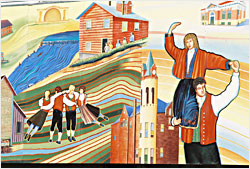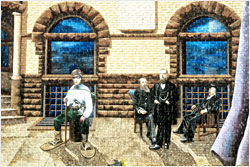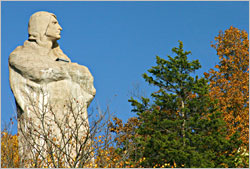Roadside Distractions II
Here's another round-up for everyone who loves the odd and offbeat.

© Beth Gauper
At MidwestWeekends, we love anything that makes us veer off the highway and say, "Wow, what the heck is that?"
We call these things Roadside Distractions, and we always take a photo.
One of our favorites: Lucette Diana Kensack in Hackensack, Minn., halfway between Brainerd and Bemidji.
The first 17-foot Lucette was created in 1952 by a grocer in this small town and dubbed "Paul Bunyan's sweetheart."
But a storm lopped off her head and damaged her back and hands, and she was replaced by this beaming, newly buxom Lucette.
For a while, a waving, midget-sized Paul Jr. stood beside her, problematic for some since Lucette still was only a sweetheart.
That is, until little Paul became legitimate with the "discovery" of a marriage license in 2001.
The Associated Press covered the story, calls poured in from around the nation, and the town sent out 500 parchment copies at $2 apiece and organized a Lucette & Paul Wedding Anniversary Weekend.
Lucette stands on the shores of Birch Lake, along the Paul Bunyan State Trail.
For more, see Paul Bunyan in Minnesota and Bicycling the Bunyan.

© Beth Gauper
Hobo in Starbuck
The 8-foot hobo of Starbuck is on Lake Minnewaska in west-central Minnesota.
During the Depression, hundreds of out-of-work men rode the rails into Starbuck, where they looked for work or food and, at night, gathered in a wooded area along the shores of the lake.
Many townspeople befriended the men, and the gathering spot became known as Hobo Park.
Starbuck also is known for baking a 70-foot piece of lefse, the Scandinavian flatbread, setting the world's record.
A good time to visit this summer would be August, when Starbuck holds a Dragon Boat Festival on the lake, and late July, when Glenwood holds its Waterama festival on the other end of the lake.
The town of Alexandria is 25 miles to the north, where you can see another very large traveling man: Big Ole the Viking.
For more, see Alexandria's enigma.
Welcome to Stoughton
The first things most visitors see is this "Velkommen til Stoughton" (Welcome to Stoughton) mural in this southern Wisconsin town.

© Beth Gauper
Stoughton, 20 miles south of Madison, has been devoutly Norwegian since early immigrants made it a tobacco-growing and wagon-manufacturing center.
It calls its annual Syttende Mai celebration the largest outside Norway, and it might be the largest anywhere.
Its first Syttende Mai ball was held in 1868, and its celebrations have been tourist attractions since the turn of the century.
The mural is on a building along the Yahara River. The twirling young folks are the town's famed Norwegian Dancers.
For more, see Syttende Mai in Stoughton and Celebrating Syttende Mai.

© Beth Gauper
Snow gauge on the Keweenaw
The 32-foot snow gauge on Michigan's Keweenaw Peninsula is along U.S. 41 between Mohawk and Phoenix.
This is Big Snow country, with an average snowfall of 187 inches. The record high, 390.4 inches, was set in the winter of 1978-79, and the low of 81.3 was set in 1930-31.
For more about this peninsula on Lake Superior, see Digging the Keweenaw.
The black duck of Blackduck

© Beth Gauper
The black duck is in Blackduck, a small town that's northeast of Bemidji in northern Minnesota.
It's about as northwoods as you can get, next to Blackduck State Forest and on the edge of Chippewa National Forest.
This 1985 fiberglass duck is one of several in the town, where hunting and fishing are favorite pastimes.
The original black duck was made in 1938, the year after Bemidji's giant Paul Bunyan first made a splash. That year, it rode on a float in Bemidji's Winter Carnival with Paul Bunyan's rifle, which actually fired.
The 16-foot duck also spent a week in a Dayton's display window in St. Paul, where it appeared in the Winter Carnival there.
For more, see Bemidji's behemoths.

© Torsten Muller
Hiawatha in Ironwood
The 52-foot giant Hiawatha is in Ironwood on Michigan's Upper Peninsula, just over the Wisconsin border.
Built in 1964 and named for the noble brave of Henry Wadsworth Longfellow's 1855 poem "Song of Hiawatha," this imposing fellow wears a feathered headdress and fringed buckskin leggings and cradles a peace pipe.
Ironwood calls it "the world's tallest and largest Indian."
From U.S. 2 in Ironwood, turn left onto Douglas Boulevard, or Business 2. At the T, turn right onto Frederick Street, then take an immediate left onto Suffolk Street.
For more about the area, see Ironwood the reliable.

© Beth Gauper
The voyageur of Cloquet
This voyageur is in Cloquet, Minn., near Duluth.
French-Canadian voyageurs were the workhorses of the fur trade, paddling giant canoes laden with trade goods from the St. Lawrence Seaway to the interior of the content, returning with bales of beaver pelts.
This one stands along the St. Louis River, the largest Lake Superior tributary in the United States. With Ontario's Nipigon River, it contributes about one-fourth of the lake's annual water input.
More importantly, it connects Lake Superior to the Mississippi, via the little Savanna River. From what is now the Duluth harbor, voyageurs paddled up the St. Louis to John Jacob Astor's fur post next to the Ojibwe village of Fond du Lac.
To get to present-day Cloquet, they had to portage around the hellacious rapids in what is now Jay Cooke State Park.
The 20-foot Cloquet voyageur is made of fiberglass, though it looks like wood. It's just north of downtown in Dunlap Island Park, just off Minnesota 33.
For more about voyageurs, see Scenes from the fur trade.

© Beth Gauper
Asaph in Ashland
Ashland, Wis., is the location of this mural, one of many that celebrate the history of this town on Lake Superior's Chequamegon Bay.
The trompe l'oeil painting, on a brick building at the junction of U.S. 2 and Wisconsin 13, features Asaph Whittlesey, who founded Ashland in 1854.
In 1860, Whittlesey was elected to the Wisconsin State Assembly. To get to the state Capitol in Madison, he had to travel 235 miles by snowshoe to Sparta, where he could catch a train.
The mural is based on a famous photograph of him taken during his journey. It wraps around the corner of the building and features six other prominent residents.
Kelly Meredith and Sue Martinsen created the mural, which became so popular that locals asked for more. Now, more murals pay tribute to lighthouse keepers, veterans, lumberjacks, pilots, waitresses, jazz musicians and shop clerks, all based on real people and photos.
One of the murals shows Ashland's 1916 concrete ore dock, the world's largest and the source of the high-school team name, Oredockers. The eight-story dock has since been torn down by its owner, the Canadian National Railway.

© Beth Gauper
Three other murals are indoors. A tour guide to the Ashland Mural Walk can be picked up at the Ashland Historical Museum at 216 W. Main St.
For more about Ashland, see City on the bay.
The Woodruff penny
Woodruff, Wis., is the home of the World's Largest Penny.
The penny commemorates a fundraiser that went viral long before the Internet. In 1953, a country doctor known as "the Angel on Snowshoes" wanted a hospital for the people of Woodruff.
A local geometry teacher was looking for a way to teach his students the concept of a million. A child said, "How about a million pennies?"
They flooded in from around the world, and Dr. Kate Newcomb got her hospital.
Woodruff adjoins the popular resort town of Minocqua. For more about the area, see Minocqua's white magic and Summer in Minocqua.

© Beth Gauper
Honest Abe in Sheboygan
Honest Abe lives at the James Tellen Woodland Sculpture Garden outside Sheboygan, Wis.
Tellen's depiction of a young Abraham Lincoln splitting a log is just one of many quirky concrete sculptures in a wooded yard between town and Kohler-Andrae State Park.
James Tellen worked in a furniture factory in Sheboygan, painting decorative details. In 1942, in a hospital recovering from an illness, he was inspired by the concrete sculptures he could see in the churchyard across the street.
For the remaining 15 years of his life, he created concrete figures for the yard of his log summer cottage. Many displayed a sly sense of humor. Some depicted pioneer scenes; others reflected his Christian faith.
The sculpture garden is in a quiet neighborhood just south of Sheboygan. From Wisconsin 28, turn east on County Road EE, then go south on Evergreen Drive about 1 mile, just past Indian Mound Road.
For more, see Road trip: Wisconsin's concrete art. For more about the area, see Sights of Sheboygan.

© Beth Gauper
Black Hawk on the Rock River
The Rock River town of Oregon, Ill., is the home of Black Hawk, or the Eternal Indian.
In 1908, Chicago sculptor Lorado Taft started the 48-foot-tall concrete statue on a river bluff that once was part of an art colony that Taft founded in 1898.
Today, the statue is in Lowden State Par k, across the river from Oregon.
The statue is not a likeness of the Sauk leader Black Hawk, though Taft said it was inspired by him.
Black Hawk became a tragic figure in 1832, when he tried to lead more than 1,000 followers back to their village of Saukenuk, where Rock Island now stands.
A military force of soldiers and volunteers, including a young private named Abraham Lincoln, mobilized to stop him, and belligerent politicians and newspaper editors called for scalps.
Black Hawk fled north along the Rock River and tried to surrender. The sorry episode ended with a massacre on the Mississippi River near De Soto, Wis.
"Rock River was a beautiful country," Black Hawk said. "I loved my towns, my cornfields, and the home of my people. I fought for it."
Smokey the Bear

© Torsten Muller
International Falls is the home of Smokey the Bear.
This Minnesota paper-mill town, across the Rainy River from Fort Frances, Ont., is devoted to cutting down and processing trees, not preserving them.
The forests are next door in Voyageurs National Park, which has 344 square miles of water, islands, peninsulas and shoreline.
Smokey, who is 26 feet tall and was made in 1954, lives in Smokey Bear Park. In summer, there are concerts there on Wednesday nights.
For more about the area, see Land of big water.
For the first edition of our contest, see Roadside Distractions I.